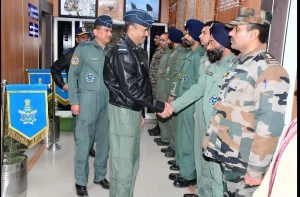ASTRA BVR Air-to-Air Missile: On August 23, 2023, near the coastline of Goa, a monumental achievement was marked in the annals of Indian defense. The Light Combat Aircraft (LCA) Tejas LSP-7 adeptly launched the ASTRA missile, which is India’s homegrown Beyond Visual Range (BVR) air-to-air missile. The test was executed at an altitude of approximately 20,000 feet and, to the satisfaction of the overseeing teams, all predetermined objectives were met, making it an ideal model for missile launches.
Several major defense institutions participated and monitored this crucial test. Among them were the Aeronautical Development Agency (ADA), Defence Research and Development Organisation (DRDO), Hindustan Aeronautics Limited (HAL), Centre for Military Airworthiness and Certification (CEMILAC), and Directorate General of Aeronautical Quality Assurance (DG-AQA). The test was further monitored with the help of another Tejas twin-seater aircraft tailing the missile launch.
The ASTRA missile is a product of intense research and development. Designed by premier institutions like DRDO’s Defence Research and Development Laboratory (DRDL), Research Centre Imarat (RCI), and several other DRDO labs, this missile is at the pinnacle of modern BVR technology, built to intercept and overpower fast-evolving aerial threats. The successful launch from the Tejas jet sends a powerful message affirming India’s commitment to its ‘Aatmanirbhar Bharat’ vision, which aims for self-reliance in defense technology.
Shri Rajnath Singh, India’s Defence Minister, didn’t miss the chance to applaud the teams from ADA, DRDO, CEMILAC, DG-AQA, and related industries for this achievement. He pointed out the twofold benefit: enhancing Tejas’s combative potential and lowering India’s dependency on foreign-made arms.
A Closer Look at the DRDO ASTRA Missile:
Astra Mk-1 Missile: Vital Features
1. Overview:
- The Astra Mk-1 is categorized as a Beyond Visual Range (BVR) Air-to-Air Missile (AAM).
- BVR missiles have the capacity to target from distances greater than 20 nautical miles or 37 kilometers.
- AAMs are missiles specifically engineered to be launched from aircraft with the mission to incapacitate other airborne adversaries.
2. Range Specifics:
- The Astra Mk-1 boasts an impressive range, approximating 110 km.
- The next iteration, the Mk-2, which is still in the developmental stages, aspires to achieve a range surpassing 150 km.
- Future blueprints include the Mk-3 variant, which will further extend this range.
- There’s also work on another Astra variant with a range that’s more compact than the Mk-1.
3. Origin and Development:
- This missile is a product of meticulous work by the Defence Research and Development Organisation (DRDO).
4. Strategic Importance:
- Indigenization and Autonomy: The Astra is customized to cater to the precise needs of the Indian Air Force (IAF). The primary aim is to reduce the nation’s dependence on external missile systems. With BVR capabilities, Astra ensures that Indian jets can neutralize airborne threats without breaching the defensive zones of adversaries.
- Technological and Economic Superiority: Astra stands out, surpassing several foreign counterparts in both technological sophistication and cost efficiency. Capable of achieving velocities that are over four times the speed of sound and climbing up to altitudes as high as 20 km, it brings a new dimension to aerial combat.
- Compatibility and Future Integration: While the Sukhoi 30 MKI is the current platform integrated with Astra, plans are afoot to include it in the armament of other aircraft like the LCA Tejas. In the future, integration with MiG-29K jets is also on the cards, boosting the combat capabilities of India’s naval air fleet.
The in-depth exploration of the Astra Mk-1 underscores its transformative potential in redefining India’s defense mechanisms.



















